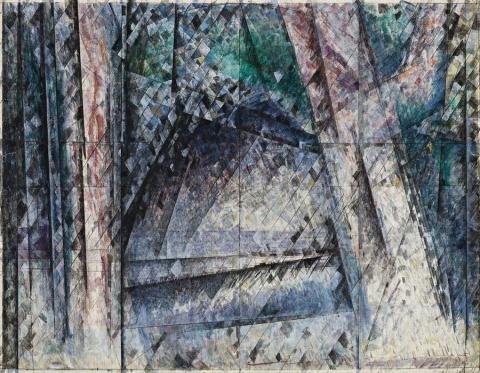TREES AND MOUNTAIN, MOONLIGHT, 1957-62
GODFREY MILLER
oil, pen and ink on canvas
47.0 x 61.5 cm
signed lower right: Godfrey Miller
Artarmon Gallery (Artlovers), Sydney (label attached verso, as 'Blue Landscape')
R.A. Henderson collection, Sydney
James R. Lawson, Sydney, 15 September 1987, lot 183 (as 'Blue Landscape')
Peter Gant Fine Art, Melbourne, 17 May – 14 June 1988, cat. 14
Dudley Cain collection, Melbourne
Harold and Connie Slater collection, Sydney
Thence by descent
Private collection, Sydney
Possibly Godfrey Miller Memorial Exhibition, Darlinghurst Galleries, Sydney, 16 February – 27 March 1965, cat. 8 (as 'Blue Landscape')
Godfrey Miller 1893–1964, Art Gallery of New South Wales, Sydney, 15 March – 5 May 1996;
National Gallery of Victoria, Melbourne, 15 May – 17 June 1996 (as 'Trees and Mountain, Moonlight')
Henshaw, J., (ed.), Godfrey Miller, Darlinghurst Galleries, Sydney, 1965, pl. 20
Art and Australia, vol. 25, no. 3, Autumn 1988, p. 302
Edwards, D., Godfrey Miller 1893–1964, Art Gallery of New South Wales, Sydney, 1996, pp. 73, 74, 124, pl. 64 (illus.)
Looking at Godfrey Miller's paintings recalls those lines from William Blake's Auguries of Innocence written in about 1803:
To see a world in a grain of sand,
And a heaven in a wild flower,
Hold infinity in the palm of your hand,
And eternity in an hour.
A mystic, like Blake, the contemplative Miller explored the unity of the ultimate reality. Through his unique vision, he reduced all things to their essentials, developing an architectonic figuration combining the simplicity of complexity to touch upon the universal. Seen in his choice of subjects - the still life, landscapes, and nudes - forms express the fundamental, dressed deferentially in subdued colours, of cubes evoking the three dimensional, yet flat. They echo his earlier training as an architect, and reveal the creative influences of Paul Klee and Picasso. His work is characterized by an inner serenity as it moves seamlessly between figuration and abstraction.
Trees and Mountain, Moonlight, c1957-621 is a classic painting concentrating on two of his favoured motifs -trees and mountains. Its monumental presence is achieved through the harmonious balance of verticals and horizontals. The bulk of the mountain is offset by the weight of the framing tree trunks, with angles answering each other. Colour, reduced to modulations of tone, creates the moonlight effect in sight and mood, moving in its silence. Faceted, as in a mosaic, each segment seems to reflect its own light as well as that of the moon. An overall flickering effect is commanded by stillness, as if time has ceased. Equally miraculous, the mountain and trees seem weightless, floating images, as insubstantial and intransient as all things. As ever, Miller is a master of the paradox, providing the viewer with the path on which to tread.
Given to painting in series, Miller's Trees and Mountain paintings are not only among his finest, but also make a profound contribution to the genre of Australian landscape painting. Memorable landscapes include Trees in Quarry, 1952-56 (Archer M. Huntington Art Gallery, Texas, United States of America), Blue Unity, 1954-57 (National Gallery of Australia, Canberra), and Trees in Moonlight, 1955-57 (Queensland Art Gallery, Brisbane). Like Trees and Mountain, Moonlight, c1957-62, their inspiration owes much to Central Australia, which Miller visited in 1940 and continued to visit. In 1954, he wrote to Melbourne art critic Alan McCulloch, 'I was on an excursion ... into Centre of Australia - out from Alice, 350 miles to Ayers Rock, camped 5 nights, and on to Mt Olga. All of which I hope will influence my painting ... It was a strange experience to be in the dark of night, to drink tea in the early dawn, to be in the presence of such size, colour uniqueness.'2
1. Miller often worked on his paintings over a long period, as the date given indicates
2. Letter to Alan McCulloch, 20 September 1954, quoted in Edwards, D., Godfrey Miller 1893 -1964, Art Gallery of New South Wales, Sydney, 1996, p. 70
DAVID THOMAS
